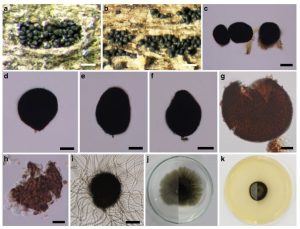Subglobosporium tectonae Doilom & K.D. Hyde, Index Fungorum number: IF551971
Etymology: Name refers to the host genus Tectona.
Holotype: MFLU 15–3560
Saprobic on bark of dead and living T. grandis. Sexual morph: Undetermined. Asexual morph: Colonies on natural substrate, punctiform, superficial on outer and inner bark, in pits or cracks on outer bark, gregarious, scattered, black, globose to subglobose. Conidiophores undetermined. Conidiogenous cells undetermined. Conidia (78–)87–94(−101) high × (62–)80–85(−98) μm (x = 88 × 80 μm, n = 20), globose or subglobose to ellipsoidal, 1-celled, black, becoming reddish when crushed, containing hyaline granularcontents.
Culture characteristics: Conidia germinating on PDA within 24 h. Germ tubes produced around conidia. Colonies on MEA reaching 11–13 and 13–17 mm diam. after 7 and 10 days respectively in the dark at 25 °C (x = 12.5, 15.4 mm for 7 and 10 days respectively, n = 5), undulate, flat or effuse in the center, immersed at the edge, superficial on old colony plugs at the center, slowly growing, after 10 days, pastel grey (1D1) from above, yellowish brown (5F6) from below.
Habitat: Known to inhabit bark of dead and living T. grandis (current study).
Known distribution: Thailand (current study).
Material examined: THAILAND, Chiang Rai Province, Muang District, Ban Doo Subdistrict, on dead bark of T. grandis, 15 July 2012, M. Doilom & S. Luesuwan, (MFLU 15–3560, holotype), ex-type living culture MFLUCC 12–0393, MKT 066, ICMP, GenBank Accession No: ITS: KU712445, LSU: KU764703, RPB2: KU712485, SSU: KU712464; Chiang Rai Province, Mae Chan District, on bark of living T. grandis, 1 July 2012, M. Doilom, (MFLU 15–3529, paratype), ex-paratype living culture MFLUCC 12–0390, MKT 063, ICMP, GenBank Accession No: ITS: KU712446, LSU: KU764702, RPB2: KU712495, SSU: KU712463.
Notes: Subglobosporium is introduced as a new genus in Pseudocoleodictyosporaceae with Su. tectonae as the type species. The characteristics of Subglobosporium are conidia in punctiform, superficial colonies in pits or cracks on bark, black, globose to subglobose on natural substrates. It is proposed that Subglobosporium has a unique morphology compared to other hyphomycetes (Seifert et al. 2011). This genus forms a distinct lineage from other taxa in Dothideomycetes based on LSU sequence data which was obtained from Hyde et al. (2013), as well as multi-gene phylogenetic support in this study.
FIG Subglobosporium tectonae (MFLU 15–3560, holotype). a Conidia on outer bark of living T. grandis. b Conidia on dead inner surface of bark. c–f Conidia. g Close-up of conidia wall. h Crushed conidium. i Germinated conidium. j Colony on PDA after 10 days (above and below views). k Colony on MEA after 10 days (above and below views). Scale bars: a, b = 200 μm, c = 50 μm, d–f, i = 30 μm, g, h = 20 μm

